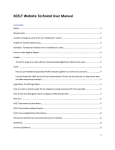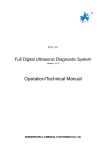Download “Don`t Get too Stressed” PHEOCS Investigation
Transcript
“Don’t Get too Stressed” by: Ethan Burghardt PHEOCS Investigation There are many things that can happen when you are scared. First, your muscle cells lose polarity. When you are at rest your muscle cells are polarized. When they are facing emotions, there are an excess amount of ions across the muscle cell membranes. These ions are positive sodium ions. An excess amount of these causes a positive charge on the cell membrane. An EKG (or ECG) sensor can read the potential positive charge of the cell membrane in millivolts. (mV) Information was found on the EKG sensor manual provided by Vernier PHEOCS Background Information Questions Found at http://answers.webmd.com/answers/1182407/what-is-a-normal-heart-rate PHEOCS Background Information Questions Cont. PHEOCS Background Information Commonly asked questions What is an EKG? -An EKG is a graphic recording of your heart’s electrical activity. What does it do? -The EKG sensor can give your cardiologist a full view of your hearts well being, history, and health. Are there any risks? -No there is not. An electrocardiogram is a safe and painless test, with no known risks. An EKG is not for you if you are allergic to any adhesives or hospital grade tape. The Surgeon General himself has declared that there is no need for a consent form in the instance of and EKG. Found at: http://www.childrenshospital.org/az/Site494/mainpageS494P1.html PHEOCS Background Information- FAQs Contacting Experts My expert is Mrs. Lisa Johanek, PhD of neuroscience. One of her suggestions was: My questions were quite simple. 1. Do you agree with my hypothesis? 2. Do you have any recommendations to add to my experiment? 3. Do you see any flaws in my experiment? [email protected] PHEOCS Background Information- Contacting Expert Hypothesis A stressful environment will cause a rise of potential mV in the heart. PHEOCS Hypothesis Setting up Labquest and sensor. 1. Turn on the Labquest by pressing red power button. 2. Plug the white connector plug into the CH 1 port that can be found next to the red power button. Take care to line up the tapered end to the tapered slot. If it doesn’t seem to fit properly without forcing it please see a teacher. 3. Select the measurement of potential mV. 4. Next select the duration button on the right to pull up its menu. Change the duration of data collection by pressing in the white box that has a number there. Change this number to read 900 (15 min) and press done. Then press OK. 5. Now switch to the graphing mode by pressing the graph icon on the upper right (the graph with a red line on it) 6. Your LabQuest and data logger is now ready to collect data. PHEOCS Designing experiment Your EKG sensor will look like this when taken out of the package. It will include the sensor, 100 electrodes, and a user manual. PHEOCS Designing experiment Test Procedures 1. Put one electrode on the left medial basilic vein. (The visible blue vein on the forearm) 2. Pun another electrode on the right medial cubial vein. 3. Put another in-between the right cephalic and dorsal venous veins. 4. Clip the green clip to the right forearm electrode. ( - negative) 5. Clip the red clip to the left forearm electrode. ( + positive) 6. Clip the black clip to right inside wrist. ( reference) 7. Press the run button on the LabQuest. (Green triangle at the bottom left of the screen) 8. Wait for the test to be over or for the time to run out. (The LabQuest will automatically stop running when time runs out) 9. Press file then press save. 10. Type in the name of the experiment. PHEOCS Designing experiment Test Procedures cont. This is how your EKG sensor will look when set up properly on the subject. PHEOCS Designing experiment The table describes the variables, conditions, and results. It was used to plan the experiment as well as set it up before running it. Haunt and Elementary are both horror based games. The test were ran in an isolated environment. PHEOCS Data Table Materials List Vernier Lab Quest Vernier EKG sensor (EKG-BTA) Hp ProBook 6560b SanDisk Cruzer 4 gb mass flash storage device Apple ipod touch 4th gen, 32 gb Apple licensed headphones Vernier Q-Trace EKG electrodes Fuji Film XP Digital Camera The Oxford Handbook of Functional Data Analysis (US LOC Control #2010032107) Methods for Data Acquisition and Evaluation of Electro-Cardiograms (US LOC Control #75372482) Vernier Logger Pro 2 desktop software SLENDER The Game (product version 3.5.3.44447) (file version 3.5.3.44447) “Chasing Cars” Snow Patrol “Scatta” Skrillex (featuring Foreign Beggars and Bare Noise) 2004 HAUNT The Game (product version 3.5.6.44817) (file version 3.5.6.44817) pub. By Microsoft Studios PHEOCS Designing experiment This is the third test conducted on Sam VanBuskirk. This was conducted on 1/28/13 at 11:00 AM on The amount of mV with the variable of fear PHEOCS Observations This is the resting mV conducted on Sam VanBuskirk. PHEOCS Observations This is the compiled mV test conducted on 2/1/13 at 9:45 AM on Brooke Jahner. These spikes are muscle contractions in the forearms when stressed. These are not apparent From the surface of the skin. PHEOCS Observations Explanation In the test on the previous slide, the spikes are muscle contractions in the forearms when stressed. These are not apparent from the surface of the skin. My expert (Lisa Johanek) recommended that I add this for clarity of the experiment that was ran. Link to the information emailed by Lisa Johanek below. https://docs.google.com/a/foxwestacademy.org/viewer?a=v&pid=gmail&attid=0.1&thid=13ca7d0047adac37&mt=applicati on/vnd.openxmlformatsofficedocument.wordprocessingml.document&url=https://mail.google.com/mail/u/0/?ui%3D2%26i k%3Dbec242aaa6%26view%3Datt%26th%3D13ca7d0047adac37%26attid%3D0.1%26disp%3Dsafe%26zw&sig=AHIEtbTAYac 8QDS8Y-FePHANDcSHFHPJ2A PHEOCS Observations Conclusion Based on my research I have concluded that rises in emotion, stress, and fear will cause a flourish in potential mV and sodium ions in the heart. -Rises in emotion will cause flourishes in sodium ion levels on the muscle cell membranes. -There are many different things that can cause the heart to rise in polarity and charge. PHEOCS Conclusions Written Observations -On test 3 the left forearm electrode was bumped causing an un natural and un necessary spike on the data collecting. -On test 4 the right wrist electrode was bumped causing an un natural spike in data collecting. PHEOCS Observations Applications Information from an EKG can be used in many ways. -An electrocardiogram can detect many diseases such as coronary heart disease. -EKGs can show heart arrhythmia. -Congenital heart defects or birth defects of the heart. -An EKG can tell if you are at risk for heart failure. -Heart valve disease prediction -Inflammation of the sac that surrounds the heart. (Pericarditis) -Heart muscle that's too thick or parts of the heart that are too big (cardiomyopathy) Found at: http://www.nhlbi.nih.gov/health//dci/Diseases/ekg/ekg_show.html PHEOCS Observations Credits and Resources Vernier US Library of Congress Mark J. Hadley of Parasec Productions SanDisk Apple inc. Hewlet Packard inc. Lisa Johanek, Phd of neuroscience Fuji Flim corp. NanaOn-Sha and Zoë Mode PHEOCS Cite resources






























